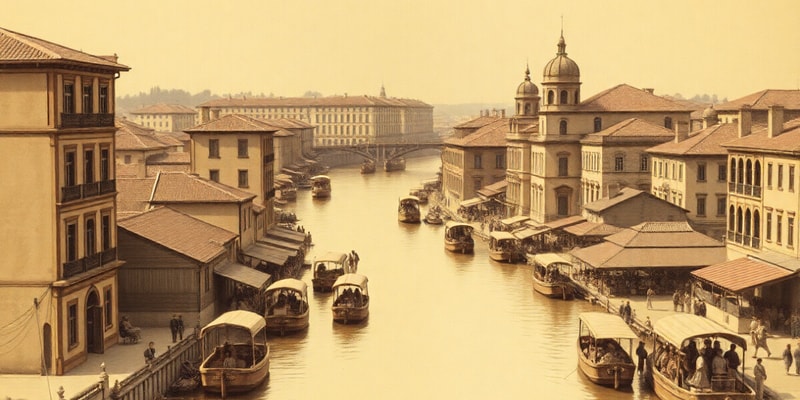Podcast Beta
Questions and Answers
What characterized the economies of rural areas compared to urban areas in pre-colonial India?
Which cities are mentioned as flourishing during the 16th and 17th centuries?
What was a key feature of Mughal-era cities in India?
Who predominantly resided in Mughal-era cities?
Signup and view all the answers
In what way did cities exert influence over rural populations during this period?
Signup and view all the answers
What was a primary reason for the decline of cities like Dhaka and Murshidabad during British rule?
Signup and view all the answers
Which of the following cities gained significance as trade centers due to shifts in British trade routes?
Signup and view all the answers
What effect did the introduction of mass-produced goods from Britain have on local producers?
Signup and view all the answers
Which factor did NOT contribute to the urban changes in India during the British rule?
Signup and view all the answers
What characterized the urbanization process in cities like Bombay and Calcutta during this period?
Signup and view all the answers
What characterized the layout of urban centers during the Medieval Period in India?
Signup and view all the answers
Which of the following cities experienced significant religious importance and commercial activity in the transition to the 18th century?
Signup and view all the answers
What factor played a major role in the urban layout of Indian cities during the Medieval Period?
Signup and view all the answers
What trend marked urban centers in the 1800s and beyond in India?
Signup and view all the answers
Which of the following statements best describes the impact of Mughal power's decline on urban centers?
Signup and view all the answers
What significant infrastructure development began in India in 1853?
Signup and view all the answers
What was one consequence of the railway expansion in India?
Signup and view all the answers
By 1900, what percentage of the British population lived in villages?
Signup and view all the answers
Which Indian city is noted for its industrial center during the British rule?
Signup and view all the answers
What hindered faster urbanization in India compared to Europe?
Signup and view all the answers
What factor contributed to the population shifts in Britain during the industrial revolution?
Signup and view all the answers
How did colonization policies affect the agricultural base of Indian cities?
Signup and view all the answers
What was the primary function of the factories established by the East India Company in pre-sidency cities?
Signup and view all the answers
Which fort was established in Madras by the East India Company?
Signup and view all the answers
What were the designated areas for the British and Indian populations called in pre-sidency cities?
Signup and view all the answers
What was a significant factor that led to the fortification of pre-sidency cities?
Signup and view all the answers
Which of the following contrasts are highlighted in the comparison between pre-colonial and colonial cities?
Signup and view all the answers
During which century did the development of pre-sidency cities like Calcutta, Bombay, and Madras occur?
Signup and view all the answers
Which city had Fort William as one of its fortifications?
Signup and view all the answers
What was the primary purpose of the fortifications built around pre-sidency cities?
Signup and view all the answers
Which of these cities was NOT mentioned as a pre-sidency city in the provided information?
Signup and view all the answers
What was Bhagalpur's identity in ancient times?
Signup and view all the answers
Which significant cultural influence was prominent in Bhagalpur between the 12th and mid-18th century?
Signup and view all the answers
What demographic change occurred as the city developed?
Signup and view all the answers
How did the growth of professions affect the middle class in Bhagalpur?
Signup and view all the answers
What roles did the new working class primarily undertake?
Signup and view all the answers
In what way did women's roles change in Bhagalpur's society?
Signup and view all the answers
What societal change occurred with the establishment of new schools and colleges?
Signup and view all the answers
What happened to the city of Champā in relation to Bhagalpur over time?
Signup and view all the answers
What type of housing did many laborers from rural areas typically occupy in Bhagalpur?
Signup and view all the answers
Study Notes
English Rule and Urban Changes
-
Colonial Era Impact on Cities: Cities saw dynamic transformation during the 18th century due to British rule.
- Early European trading companies established commercial centers in various cities.
- These centers played a vital role in developing trade routes and fostered the growth of surrounding urban areas.
-
Trade Route Shifts and City Decline:
- Transition to new port cities under British influence led to decline of older cities.
- Cities like Dhaka, Murshidabad, Surat, and Machilipatnam faced challenges in their traditional industries.
-
Factors Influencing Urban Changes:
- Shifting trade routes: New port cities under British control changed the flow of commerce.
- Competition: The introduction of British mass-produced goods led to local producers losing markets.
- Political power shifts: British East India Company's victories reshaped centers of power and influence.
- Emerging industries: New industries spurred urban development.
-
Impact on Cities and Society:
- New populations migrated to centers of administrative and commercial activity.
- The rise of trade and commerce resulted in changes in employment patterns and city demographics.
- The changes impacted the social structure and culture of cities.
Historical Analysis of Urban Centers
- Medieval Period: Cities were fortified and contained palaces, temples, mosques, schools, markets, and inns.
- 18th Century Transition: Cities like Madurai, Tanjore, and Kanchipuram held significant religious importance and commercial activity.
-
19th Century and Beyond: Urban centers experienced significant changes.
- New cities like Nagpur, Baroda, and Hyderabad rose to prominence.
- The decline of Mughal power and the emergence of new regional centers also added to the urban landscape.
- The growth of trade and new administrative systems fueled 19th-century urban development.
The Growth of Towns and Cities in India During British Rule
- Introduction of Railways: The railway system in India started in 1853, leading to the establishment of new cities.
- Industrialization and Urbanization in Europe: The growth of European industrial cities was tied to the textile and metal production boom.
- Urbanization in Britain: The industrial revolution in Britain caused a massive shift of population from rural areas to urban centers.
-
Urbanization in India: While industrial centers developed, urbanization in India wasn't as rapid as in Europe.
- Unequal policies favored British industries and led to decline in agriculture.
- The pre-colonial economic base of Indian towns and villages wasn't significantly disrupted.
Pre-sidency Cities Settlement
-
East India Company's influence: The East India Company established factories in cities like Calcutta, Bombay, and Madras. These became collection centers for trade goods.
- Competition among European trading companies led to fortifications around these cities.
- The areas became known as "White Town" (British) and "Black Town" (Indian).
The City of Bhagalpur
-
Bhagalpur's History: Located on the southern bank of the Ganges River, Bhagalpur has existed for around 3000 years.
- Formerly a suburb of Champā.
- Under Muslim rule from the 12th to the mid-18th century.
- Significant center for Sufi culture.
-
Bhagalpur's Transformations:
- Rise of towns, parks, and stadiums led to increased social interaction.
- Growth of professions like lawyers, doctors, and engineers resulted in a growing middle class.
- Education expanded with new schools, colleges, and libraries.
- Arrival of a new working class consisting of rural migrants.
- Women began entering the public sphere as teachers, artists, and factory workers.
The City of Bhagalpur During the Colonial Period
-
Bhagalpur as a Traditional City:
- Formed from three towns: Champā, Bhagalpur, and Barārī.
- Narrow, winding streets housed communities based on caste, religion, language, and profession.
-
Migration and Demographic Changes:
- Expansion of modern education, land revenue systems, and business opportunities brought in Bengali and Marwari people.
- Bengalis took a prominent role in education, with doctors, lawyers, engineers, professors, clerks, teachers, and writers from Bengal.
- Marwari groups dominated commerce as traders, agents, bankers, and money lenders.
Historical Structures in Bhagalpur
- Types of Structures: Masjids, Mazaars, Makbaras, Khanqahs, Idgahs, and Imambaras were important religious and community centers, playing a significant role in the city's social and cultural life.
- Structures in Bhagalpur: Several buildings are significant, including a Masjid associated with a local figure.
Image Descriptions
- Image 4: A large gathering of people at a Masjid, possibly for prayer.
- Image 5: A grand mausoleum (makbara).
Summary of the Instrument
- Bhagalpur During British Era: Bhagalpur's demographics shifted due to increased job opportunities and educational possibilities.
- Economic Activities: Weaving and textile-related jobs attracted people.
- Poverty and Migration: Poor migrants seeking opportunities lived in crowded areas near the Ganga River.
Image Description
- The image showcases a poor residential area, likely in the Mayanganj locality of Bhagalpur.
महाशय ड्यौढ़ी
- Construction: This grand structure was built in the late 18th century in Bhagalpur by a local landlord named परेशनाथ घोष.
- Historical Context: The construction occurred during the transition from Mughal rule to British rule.
- Landlord's Family: The family held administrative positions under the Mughals and obtained land rights after acquiring them from the British.
- British Rule Impact: Bhagalpur became an important area with essential institutions (temples, schools, hospitals, orphanages).
Studying That Suits You
Use AI to generate personalized quizzes and flashcards to suit your learning preferences.
Description
Explore how British colonial rule transformed cities in the 18th century. This quiz delves into the establishment of new trade routes, the decline of older cities, and the factors that influenced these urban changes. Test your knowledge on the dynamic transitions cities underwent during this period.




